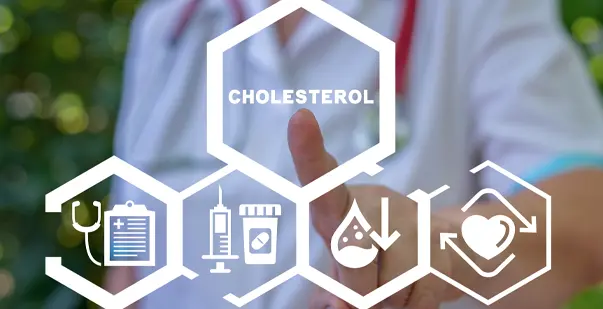
Last Updated On: January 10, 2025
Do you know high cholesterol is also known as a “silent killer.” No wonder! It shows no symptoms until it’s too late. A high cholesterol level or hyperlipidemia leads to life-threatening conditions like chest pain and heart attacks.
One type of hyperlipidemia is hypercholesterolemia. It means that your blood has too much low-density lipoprotein (LDL), which is considered bad cholesterol. This high concentration of LDL increases the risk of stroke. Studies show that reducing the level of LDL cholesterol results in lower cardiac events.
On the other hand, HDL (high-density lipoprotein) cholesterol has lower heart risks. It is safe because HDL transports extra cholesterol to the liver, where it is safely disposed of. Thus, it doesn’t add more risk to diseases associated with the heart.
If you’ve recently been diagnosed with high cholesterol, you may be intimidated by what’s next. Well, don’t worry. We’ll cover everything you need to know about high cholesterol treatment. From initial prognosis and diagnosis to exhaustive treatment options, this blog post will help you manage your cholesterol level effectively.
Cholesterol is a wax-like substance that helps the body create cell membranes, different hormones, and Vitamin D. The body’s two sources of cholesterol are the liver and the food we eat.
Cholesterol is transported in the bloodstream through lipoproteins, which are commonly known as LDL (low-density lipoprotein) and HDL (high-density lipoprotein).
LDL cholesterol is often known as bad cholesterol because it grows in arteries, increasing the risk of heart disease. HDL, on the other hand, is removes good cholesterol because it removes LDL (bad cholesterol) from the coronary arteries.
The recommended cholesterol level varies depending on the age, gender, and family history of heart disease. However, we have listed a general recommendation for cholesterol levels:
Note: If you are not diagnosed with any heart or blood vessel disease and your overall cardiac risk is low, the LDL cholesterol should be below 100 mg/dL.
High cholesterol is typically diagnosed through a regular blood test. This test is popularly known as lipid profile or lipid panel. It generally reports about:
You are required to fast for 9-12 hours before the blood test. You should abstain from eating any food or liquid except water. However, there are a few cholesterol tests that don’t require fasting. Hence, follow your doctor’s instructions accordingly.
Certain lifestyle patterns and health conditions increase the risk of high cholesterol. While some risk factors, like family history, gender, and age, cannot be controlled, certain behaviors are. Here is a list of risk factors associated with high cholesterol.
Non-HDL cholesterol can increase the risk of heart disease. Thus, you should take steps to lower your bad cholesterol. For this, you can make some simple lifestyle changes and take medications to help you maintain your body’s cholesterol level. So, here are some management options and treatments for High non-HDL cholesterol:
Your doctor may suggest heart-healthy lifestyle changes as the first step to lowering your high cholesterol. Here are some of those lifestyle changes that can help you regain your normal cholesterol level.
Although lifestyle changes are beneficial to maintain cholesterol levels, they may not be the only treatment. In that case, your doctor may recommend some medications. The choice of medicines and drugs depends upon factors like your age and health. However, common choices include:
Like all medicines, cholesterol-lowering drugs also cause some side effects. In most cases, these side effects are mild and may go after a certain period. The common side effects of such medications are:
Thus, it is advisable to consult with your doctor regarding side effects and whether you should continue taking the drugs.
Here are a few questions that you may ask your doctor if you find out your cholesterol level is high.
High blood cholesterol levels can adversely affect cardiovascular health. If you are worried about your cholesterol level rising above the normal range, there are practices to prevent the same:
Along with a healthy diet, keep yourself fit and maintain a normal weight to lower cardiovascular risks. This will thereby minimize the chances of other health problems like obesity and diabetes. Even if you lose 5 to 10% of your weight, you will be able to lower the risk of cardiovascular disease significantly.
Adults over age 20 should have cholesterol measured once every five years. This gives both the patient and the doctor an opportunity to act on increased cholesterol early if it starts to rise.
Low-cholesterol foods such as oats, beans, nuts, and olive oil contain monounsaturated fats. Moreover, foods like fish and canola oil contain polyunsaturated fats, which improve heart health.
If you are an adult and haven’t had your cholesterol level checked lately, make an appointment with your doctor. Regular screenings help track changes in cholesterol levels over time. Here are some tips on how to prepare for the appointment. Make a list of:
Hence, regular check-ins with your doctor are vital for monitoring your cholesterol level and heart health. These appointments allow you to adjust the treatment plan, which, in turn, ensures that you are managing your cholesterol level effectively.
The increase in high cholesterol levels among people suggests how important it is to determine high cholesterol treatment. Regular checkups and following doctors’ recommendations can protect you against life-threatening heart diseases.
So why wait? Start your journey today and equip yourself with cholesterol-related information from a reliable authority. With the right knowledge, you can surely make a big step towards improving your heart health for good!
Read More: